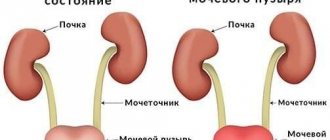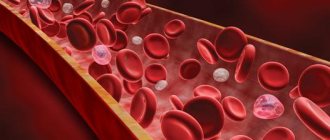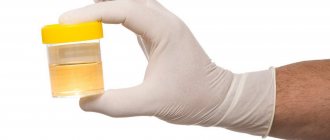Cystitis is a disease that brings great discomfort to a person’s life. Most often, women face such problems. One of the complications of inflammatory processes occurring in the mucous membrane of the bladder is hematuria - the presence of traces of blood in the urine. Treatment of cystitis with blood in women begins after a diagnostic examination, which will help to exclude other pathologies characterized by similar symptoms. For example, pyelonephritis, urolithiasis or urethritis. The symptoms of these diseases in women are very similar. Cystitis in the initial stage of development is manifested by nonspecific signs (mainly dysuric disorders):
- Frequent urge to urinate. A woman feels the need to go to the toilet every 10–30 minutes, although a small amount of urine is released during urination.
- During the process of emptying the bladder, severe cutting pain appears.
- Constant pain in the area located slightly above the pubis.
- The pain intensifies if you press on the bladder, and can radiate to the perineum and other parts of the pelvis.
If such symptoms are detected, it is recommended to immediately consult a doctor who will diagnose and prescribe a course of treatment. Even urine with blood is not an unambiguous and indisputable sign of hemorrhagic cystitis in women .
Blood in the urine with cystitis appears in the same way as with other diseases of the genitourinary system, ranging from glomerulonephritis to oncological lesions of organs. Before developing a treatment program for hemorrhagic cystitis, a diagnostic examination is prescribed, which includes studying the results of a blood test and ultrasound. Depending on the number of red blood cells found in the urine, macrohematuria and microhematuria are distinguished.
In the second case, blood is not visually observed in the urine, but test results indicate an increased number of red blood cells. If the test results are in doubt, the doctor may additionally prescribe a cystoscopy (a procedure performed using an endoscope) and a biopsy test.
Causes of bladder inflammation with blood
Inflammation of the lining of the bladder in most cases occurs due to the entry of foreign bacteria into the human body. When bacteria enter the natural microflora of the bladder, an inflammatory process occurs. In this case, cystitis can occur not only in the standard form, but also with an admixture of blood. The reasons for this factor include the following:
- Neglect of intimate hygiene rules.
- Treatment of any disease using chemical therapy.
- Hypothermia of the body.
- Ignoring the urge to urinate.
- Injuries to the kidneys or genitourinary system.
- Recent surgical interventions of the abdominal cavity and genitourinary system.
Diagnostics
The first thing a doctor will prescribe for a patient with complaints similar to cystitis is a general blood and urine test. To confirm the diagnosis, it is necessary to verify the presence of inflammation - the blood test shows elevated ESR and leukocyte values. There are too many red blood cells in the urine, and bacterial culture will give a clear answer to the question of what pathogen caused the disease. If cystitis is caused by a bacteria, the doctor will select appropriate antibiotics.
With a viral infection, no bacteria will be found in the urine, and leukocytes in the blood will increase due to an increase in the number of monocytes. For viral cystitis, antiviral drugs are prescribed.
Bladder tissue is examined using cystoscopy; this technique helps to detect neoplasms, ulcers, stones and foreign bodies. To clarify the diagnosis, the urologist can send for an ultrasound and x-ray of the kidneys and bladder.
Only after determining the exact causes of the disease is drug treatment prescribed. In rare cases, when pharmacological drugs do not help, and the patient’s condition sharply worsens, surgery may be necessary to eliminate thrombosis or form a new bladder from part of the intestine.
How does hemorrhagic cystitis manifest?
Cystitis with blood is difficult not to notice in time, since its characteristic symptoms cause discomfort and significantly reduce the quality of life. Let's look at some symptoms of hemorrhagic inflammation of the bladder:
- The first symptom is pain when urinating. The pain is sharp, cutting in nature. The pain may radiate to the lower back or lower abdomen.
- The next sign is an almost constant feeling of a full bladder. Even immediately after urination, patients with cystitis feel a newly filled bladder. Attempts to empty the bladder in this case are unsuccessful.
Urine blood test
- Specifically, the hemorrhagic form of cystitis is indicated by blood clots or a reddish tint in the urine. This symptom is key; if you notice such a sign, consult a doctor as soon as possible.
The disease progresses gradually. First, ordinary cystitis occurs. The first symptoms are frequent urge to go to the toilet. Literally within a day, unpleasant, sometimes cutting pain appears when trying to empty the bladder.
Next, the patient notices that the urine has an unusual color or that blood clots are observed. The development period may be accompanied by low-grade body temperature. The general symptoms include severe weakness and drowsiness. If treatment is not started in a timely manner, the signs of the disease will progress every day.
Blood in urine with cystitis - is it dangerous?
It is unlikely that it will be possible to quickly cure cystitis, so the patient must prepare for long-term and complex therapy. If you leave everything to chance, complications with more severe symptoms may soon develop:
- MP tamponade (blocking the lumen with blood clots). Independent urination becomes impossible, and the risk of collapse and rupture of the walls of the organ increases.
- Pyelonephritis (inflammatory damage to the tubular system of the kidney). It develops when the inflammatory process becomes chronic and is associated with the ascending spread of infection.
- Sepsis (blood poisoning). The infection spreads and enters the bloodstream.
- Violation of the hematological profile (decrease in red blood cells), with chronic pathology.
Diagnostic measures
Despite the fact that cystitis with blood at the end of urination can be recognized for superficial reasons, urologists prescribe certain diagnostic measures.
The main diagnosis is urine testing. First, the patient needs to undergo a general analysis, this is necessary in order to count the number of red blood cells. For a more reliable study, a urine test according to Nechiporenko is prescribed. These tests are key, but if necessary, the doctor may prescribe a general blood test to determine your hemoglobin level.
Low hemoglobin levels are considered a complication of hemorrhagic cystitis. An ultrasound examination of the bladder and kidneys may also be prescribed.
Very often, a urine test can be unreliable; this often happens in women who collect a portion of urine during menstruation. Doctors recommend getting tested after the discharge ends.
Based on the test results, the doctor makes a specific diagnosis and severity, as a result of which effective treatment is prescribed.
Types of discharge
Leucorrhoea with cystitis is not a characteristic sign of the disease. They usually indicate the development of complications. It is also worth noting that the abundance of secretions may vary depending on the time of day and the woman’s activity. In any case, you need to visit a doctor who will tell you which discharges may be normal for cystitis and which ones are cause for concern.
Bloody issues
Bloody discharge may indicate damage to both the urethra and the cervix. This symptom requires a thorough examination and a series of tests.
Important! The presence of bleeding during cystitis in women, regardless of the time of their appearance and abundance, indicates that there are damaged areas on the mucous membrane.
Bloody discharge with a pinkish tint is observed when blood from the urethra after urination mixes with mucus from the vagina. This may create the feeling that the source of the problem is in the vagina. In addition, such a shade may indicate inflammation of the cervix.
Dark brown discharge is more concerning than pinkish discharge. Usually, the discovery of dark spots on underwear indicates that the infection has entered the uterus. At the same time, the risk of developing diseases such as adenomyosis or cervical erosion increases several times.
White discharge during cystitis
White discharge may indicate the development of thrush. In this case, a woman may experience severe itching in the genital area and a burning sensation. The development of thrush with cystitis is due to a decrease in the woman’s general immunity, as well as in the case of inflammation of the bladder caused by fungi.
Transparent
Transparent leucorrhoea can occur in case of hormonal disorders or menstrual irregularities. In addition, excessively abundant discharge may indicate a violation of the vaginal microflora due to the proliferation of pathogenic microorganisms. If such vaginal leucorrhoea does not have an unpleasant odor and is not interspersed with pus or mucus, then there is no particular cause for concern. This symptom will go away on its own as soon as the source of inflammation is eliminated.
Curdled discharge
A similar symptom may be accompanied by:
- severe itching of the genitals;
- unpleasant smell. It may smell strange, sour, or smell like rotten fish;
- changes in the color of the leucorrhoea up to yellow, greenish or completely dark green.
This condition indicates that inflammation from the bladder has spread to the uterus. In this case, diseases such as bacterial vaginosis, mycoplasmosis and others may occur. In this case, you need to consult a gynecologist, undergo a full examination and undergo a set of tests.
Drug treatment
Cystitis with blood occurs clearly, that is, its signs can be recognized by anyone. If you suspect the presence of this pathology, you should visit a urologist.
Depending on the severity and cause of the disease, treatment will be prescribed. Therapeutic measures must be started in a timely manner, this will help avoid the unpleasant consequences of the disease. In this case, if the disease is caused by bacteria, effective antibacterial drugs are prescribed to eliminate them.
If the cause of hemorrhagic cystitis is viruses, then it is necessary to take a course of antiviral drugs prescribed by the attending physician. Treatment of cystitis involves the following:
- Drugs are prescribed that help strengthen blood vessels and stop bleeding. Depending on the severity, drugs are prescribed in the form of tablets or in the form of injections.
- When treating cystitis, it is recommended to follow a diet. Its main criteria are the exclusion of smoked, salty and spicy foods from the usual diet. During treatment, you should never take alcohol-containing drinks, as they significantly reduce the effect of medications.
- To prevent stagnation and remove toxins from the bladder, the volume of fluid you drink should be at least 2 liters. Depending on the individual characteristics of the body, the volume can be increased to 2.5-3 liters.
- Drugs are prescribed to replenish the level of hemoglobin in the blood.
- To eliminate the inflammatory process, anti-inflammatory drugs are prescribed.
- As a supplement, it is recommended to take vitamin complexes.
In addition to basic treatment, it is necessary to follow some preventive measures to avoid relapse of the disease.
What are the signs of inflammation?
Depending on the form, the symptoms of the disease may vary. Common features include:
- frequent urge to urinate;
- burning sensation when emptying the bladder;
- cramps and severe pain in the abdomen, mainly in the lower part;
- change in the smell and color of urine;
- the appearance of sediment and impurities in it.
Treatment with folk remedies
Treatment of hemorrhagic inflammation of the bladder can be carried out using some traditional medicine recipes. Traditional treatment is recommended in combination with medications.
Let's look at a few recipes:
- Parsley has proven itself well in the treatment of cystitis with blood. On its basis, drinks are prepared that should be consumed during the general course of treatment. To prepare the drink, you need to take a bunch of dill and finely chop it with a knife. Next, place the greens in a glass jar and pour boiling water over it. You need to let the drink brew for about 5 hours. The medicine is drunk 1/3 glass at least three times a day.
- Dry leaves and stems of St. John's wort should be placed in boiling water. You will need about 50 grams of raw material per 1 liter of water. Boil the broth for half an hour. Next, the liquid should reach room temperature naturally. Drink half a glass of the drink before each meal.
- A cranberry-based drink helps with cystitis. You can use fresh or frozen fruits. You need to take an enamel bowl and thoroughly crush the berries. Next, pour boiling water (2 liters of water per 200 grams of berries) and leave for at least 6 hours. Drink 1/3 glass three times a day.
- Rose hips are no less useful for bladder inflammation. Each fruit is cut into four parts, in total you will need about 200 grams of fruit. They are poured with boiling water and left for a day. Drink one glass of liquid in the morning on an empty stomach.
About symptoms
Cystitis with blood is one of the most common inflammatory diseases of the urinary tract.
It most often affects the fair sex. Not many people know whether cystitis with blood streaks occurs in men? Men are less susceptible to this disease because they have a narrow and tortuous urethra, which is an obstacle to the development of the infectious process. The gender specificity of the disease is determined by the anatomical structure.
In women, the urinary canal is much shorter than in men and is located close to the anus. Improper hygiene procedures lead to bladder infection.
Streaks of blood in the urine occur during acute inflammation of the bladder or remission of a chronic form. Hematuria is caused by inflammatory changes in the mucous membrane of the muscular organ and its vessels. These processes lead to changes in the permeability of the vascular wall and damage to the mucous membrane.
Etiology of cystitis
Before we talk about treating blood for cystitis, let’s find out why cystitis occurs. The causes of cystitis can be very different, from infectious diseases to predisposing factors. The disease can be caused by bacteria, viruses, fungi and protozoa.
The most common cause of cystitis with blood is bacterial microorganisms. This is due to the fact that in the body of absolutely every person there are conditionally pathogenic microorganisms. If pathological processes do not occur in a person’s body, then their activity is suppressed by beneficial bacteria. If this does not happen, then microorganisms begin to actively multiply.
Dysbacteriosis contributes to the development of pathological processes.
Factors predisposing to the appearance of cystitis with blood:
- Circulatory disorders in the area of the muscular organ caused by inflammatory diseases in the pelvic area.
- Pathological processes in the urethral area, which can lead to narrowing of the lumen of the urethra.
- Violation of the anatomical integrity of the bladder and urethra, which can be caused by mechanical force or the ingress of foreign objects. They can lead to impaired urine flow.
- Tumor-like processes that interfere with the normal act of urination.
- A person systematically lacks the ability to empty the bladder in a timely manner. There is no need to hesitate to go to the toilet, since such frivolity can lead to overstretching of the muscular organ and vesicoureteral reflux (reflux of urine from the bladder back into the kidneys). Which in turn lead to a number of complications from the urinary system.
- Disruptions in the normal functioning of the nervous system.
- Decreased protective functions of the immune system.
- Incorrect location of the bladder.
- Endocrine diseases, namely diabetes mellitus, which is complicated by microangiopathy.
- Women over 55 years of age.
- Failure to comply with personal hygiene rules. Very often, the cause of cystitis in women lies in improper performance of hygiene procedures in the perineal area, which inevitably leads to infection with opportunistic pathogens.
- Hypothermia.
- Presence of sexually transmitted diseases.
- Diseases of the gastrointestinal tract, which are accompanied by constipation or diarrhea.
- Hormonal imbalance in the vagina and urethra.
- Wearing uncomfortable synthetic underwear, which constantly irritates and leads to microtrauma.
Clinic
Acute cystitis and remission of chronic cystitis have a number of characteristic symptoms, thanks to which this pathology can be accurately diagnosed. The following clinical manifestations of the disease are distinguished:
- A sharp and rapid increase in body temperature to febrile levels (380-390C).
- Sharp pain and burning sensation in the pubic area.
- The emergence of an imperative urge to urinate. Their maximum number can reach up to 4 dozen times a day. In some situations, the symptoms of the disease are manifested by the involuntary release of a small amount of urine because the person is unable to control his urge to urinate.
- Change in urine color and hematuria. During cystitis, urine with blood takes on the color of meat slop. This color is due to inclusions of blood that comes from damaged vessels.
- Acute urinary retention, which occurs due to significant loss of hemolymph.
Further in the article we will talk about what to do if symptoms of the disease are detected. Cystitis with blood at the end of urination should not be treated on your own; you should seek help from a competent specialist. Only the attending physician can know how to treat cystitis correctly.
If the patient is bothered by severe pain when urinating, then he is prescribed antispasmodic drugs such as drotaverine and papaverine. They help reduce spasm of the muscles of the muscular organ.
Anti-inflammatory drugs, such as ketorolac, diclofenac and metamizole, may be prescribed to relieve pain.
One of the main directions in the treatment of cystitis is the prescription of antibacterial drugs. After testing for sensitivity to antibiotics, a drug is prescribed that will act on the pathogen. If such studies have not been carried out, then broad-spectrum antibacterial drugs are prescribed.
As a rule, drugs from the fluorochonolon group are used to treat cystitis, for example, ciprofloxacin, norfloxacin, levofloxacin, and so on. If it is possible to establish that the cause of the disease is viruses, fungi or protozoa, then the doctor selects the appropriate etiotropic therapy. With adequate treatment, you can get rid of the disease within a week.
In case of drug coma, a patient with blood in the urine due to cystitis in women is prescribed special diuretic herbal preparations and herbal teas. However, you should not treat yourself with traditional medicine without consulting a doctor. If your friend had similar symptoms, this does not mean that the treatment is prescribed the same in all cases.
There is no need to neglect following a diet, since it helps to quickly cure cystitis with blood in women and strengthen weakened immunity. It is necessary to eat light and non-irritating food.
You should drink more water, this helps flush out pathogens and reduce the concentration of urine, which reduces the irritating effect on the bladder wall.
During treatment, you should completely avoid drinking alcoholic beverages, spicy and pickled foods.
Diagnostics
A preliminary diagnosis of the disease can be made based on characteristic symptoms. To confirm the diagnosis, laboratory and instrumental research methods are used.
A clinical urine test, Nechiporenko urine test, and bacteriological urine culture are performed. It is used to isolate bacteria and determine sensitivity to antibacterial drugs.
In some cases, an ultrasound examination of the pelvic organs, cystoscopy are performed, and if tumor-like formations appear, a biopsy is performed.
Complications
If a person does not consult a doctor when symptoms appear or self-medicates without medical education, the following complications may occur:
- Transition from an acute form of a pathological process to a chronic form.
- Antibiotic resistance.
- The emergence of new diseases in the genitourinary system.
- Blood in cystitis causes anemia due to constant blood loss, and in some cases severe bleeding may occur.
- Transition of an acute form of a pathological process into a chronic one.
- Vesicoureteral reflux.
- Bladder tamponade. In this phenomenon, blood clots lead to blockage of the lumen of the urethra. As a result of this phenomenon, the secretion of urine from the body stops and overstretching of the muscle organ occurs.
- Untimely use of medications or an incorrectly selected course of antibiotic therapy can cause a generalized infection or, in other words, sepsis.
- Lability of the nervous system and nervousness are very common in patients suffering from cystitis, since the quality of life suffers greatly due to the pathological process in the body. It is very difficult to do your usual activities when you are worried about constant pain and the urge to urinate at any time of the day.
- Interstitial cystitis. When the inflammatory process, in addition to the mucous membrane, covers the muscles. Without treatment, after some time the organ becomes deformed, which ultimately leads to disruption of its normal functioning.
It's no secret that it is easier to prevent a disease than to treat it over a long period of time and persistently. To prevent cystitis with blood in the urine, you must:
- Regular and correct implementation of hygiene procedures.
- Wearing underwear made from natural materials.
- Treatment of acute and chronic infectious processes of the body.
- Avoid hypothermia.
- When the first symptoms of the disease appear (pain in the pubic area and change in the color of urine, you should immediately consult a competent doctor.
The root cause of the development of the disease associated with painful urination with blood is E. coli. If it settles in the urethra, it gradually moves into the bladder, which provokes the development of inflammation of its mucous membrane. In the absence of proper treatment, blood capillaries become involved in inflammation, their walls are damaged, and urine becomes stained with blood when urinating. In this case, we are talking about hemorrhagic cystitis.
What is the difference between hemorrhagic cystitis and banal acute cystitis, because with the latter, droplets of blood can also appear in the urine? Acute uncomplicated cystitis begins with the appearance of fever, then a regular urge to go to the toilet appears, urination becomes painful and can sometimes be accompanied by the release of droplets of blood at the end.
With hemorrhagic cystitis, the bladder mucosa bleeds intensely, the urine turns pink, and the urethra may even become thrombosed, which can further complicate the passage of urine. Hemorrhagic cystitis usually lasts no more than two weeks, after which the symptoms subside.
- To treat hemorrhagic cystitis, natural hemostatic teas are used - for example, from beautiful and yarrow: pour 1 tablespoon of each herb into 300 ml of boiling water. Leave the decoction for 40 minutes. Drink 30 minutes before meals.
- Sitz baths with chamomile infusion are beneficial. Three tablespoons of dried chamomile flowers are poured into 300 ml of boiling water. The broth should sit for a couple of hours. Then it is poured into a basin and diluted with water to the required volume. The duration of a sitz bath is no more than 20 minutes.
- For painful cystitis, a decoction of lingonberry and bearberry leaves will come to the rescue. A tablespoon of chopped lingonberry and bearberry leaves is poured with boiling water (420 ml). The broth is simmered in a water bath for 40 minutes and taken 50 ml before each meal.
- Take two tablespoons of dried yarrow and bearberry and one tablespoon of birch buds. All this is poured with boiling water (450 ml) and left in a water bath for 30 minutes. The infusion is drunk three times a day, 150 ml.
- To prepare an infusion of yarrow (2 tsp), cut it and pour 250 ml of boiling water. The infusion should sit for one hour, drink it in small sips throughout the day. One glass should be enough for the whole day.
- Pour two tablespoons of chamomile into a glass of boiling water and leave to steep for an hour. After this, add a teaspoon of honey to the broth. Drink this decoction three times a day – 100 ml each.
- Dill seeds are used to treat many diseases of the urinary system. For hemorrhagic cystitis, dill seeds are ground into flour, poured with 1 cup of boiling water, and allowed to brew for one hour. Drink this infusion in the morning on an empty stomach.
- Cranberry juice is useful for cystitis with blood. To prepare it, take half a kilogram of cranberries (fresh or frozen), 2 liters of water, 200 g of sugar. The berries are mashed by squeezing out the juice. Sugar is added to the resulting mass and then diluted with two liters of water. For effectiveness, the fruit drink is heated before use.
What complications will there be?
With ineffective or completely absent treatment, this form of inflammation can lead to some consequences. Let's take a closer look:
- Development of anemia. This disease implies an insufficient amount of hemoglobin in the blood. Since the blood in the urine leaves the body during cystitis, the hemoglobin level decreases.
- Kidney inflammation. In medical practice, this pathology is called pyelonephritis. If cystitis is not treated, pathogenic bacteria can cause inflammation in the kidneys.
- Blood poisoning. If there are weak blood vessels at the site of inflammation, the infection can easily enter the blood, leading to sepsis.
Symptoms
At first, there is only one sign of the disease - pain, and blood appears after two days. During the day, the patient is forced to visit the toilet up to forty times or more, this condition is especially painful at night. The patient wants to empty the bladder, but she is unable to achieve the desired effect.
After using the toilet, the pain in the stomach only increases. Even the slightest portion of urine causes a strong urge to urinate in the patient, but blood in the urine is not visible to the naked eye for a long time. Sometimes the bleeding is so severe that it does not allow urine to pass directly.
If there was blood in the urine and then suddenly disappeared, this is a positive sign indicating an improvement in the condition. Hemorrhagic cystitis quite often goes away without treatment within 15 days, but you should not get your hopes up - this is not a recovery, but a remission, which will soon worsen with even greater force. In this case, cystitis becomes chronic; it bothers the woman at varying intervals until the end of her life.
In some cases, the patient experiences an exacerbation when the ureters become blocked with a blood clot. Urine continues to flow into the bladder, but is unable to exit - the duct is blocked by a bloody clot. The bubble stretches to incredible sizes, the walls of the organ are damaged. Microtraumas are penetrated by bacteria that are carried throughout the body by blood, which leads to adnexitis, pyelonephritis and inflammation of other internal organs.
Preventive measures
Hemorrhagic cystitis is not a pleasant disease, which causes serious complications. To prevent the development of the disease, it is recommended to follow preventive measures:
- Drink more clean water and void your urine at the first urge.
- Carry out hygiene procedures for the genitals.
- Eat a balanced diet. A person should receive a lot of kilocalories and essential elements per day.
- Doctors believe that wearing thongs is one of the reasons for the development of cystitis. Try to wear them as little as possible.
- Strengthen your immune system with hardening and vitamin courses.
- Carry out intimate hygiene twice a day using baby soap.
- Avoid hypothermia and try to dress appropriately for the weather.
- In the winter season, clothing should cover the lower back.
- Drink cranberry infusion, which is rich in vitamin C, in courses.
- Treat concomitant diseases in a timely manner.
Hemorrhagic cystitis significantly reduces the quality of life and causes discomfort to the patient. At the first signs of illness, consult a doctor. To avoid pathology in the future, it is recommended to constantly follow preventive measures.
Prevention of inflammation
It is impossible to completely protect yourself from the occurrence of cystitis, but you can reduce the risk of its development by taking the following preventive measures:
- do not allow your bladder to overfill;
- do not get too cold;
- if you have a sedentary job, then get up and do a warm-up at least once an hour;
- do not wear tight underwear;
- wash your genitals before and after sexual intercourse, moving from front to back;
- do not practice vaginal intercourse after anal intercourse;
- change your underwear daily;
- wash your hands before and after using the restroom;
- eat a balanced diet;
- Change hygiene items promptly during menstrual bleeding.
What does the smell of vaginal discharge indicate?
Another sign that will help the doctor in correctly diagnosing your condition is the smell of female sexual secretion. Bacteria, which often cause several ailments at once, tend to create pathogenic microflora in the affected organs, which has a characteristic odor.
- For example, a fishy aroma often indicates the development of dysbiosis in the vagina (gardnerellosis). Gardnerella itself is present on the mucous membrane of every woman in a normal amount, not dangerous to health. In some cases (hormonal imbalances, sudden changes in the acid-base balance, etc.), these microorganisms begin to multiply rapidly, which causes damage.
- An acidic smell is a particular symptom of an infection caused by fungal pathogens (candidiasis). A similar illness usually occurs while taking a number of medications (antibiotics, hormonal agents), which seriously affect the vaginal microflora.
- Foul-smelling vaginal discharge with cystitis is considered a sign of a purulent process. The reason for this is most often sexually transmitted infections.
How to get rid of discharge
First of all, it is worth understanding that it is possible to completely get rid of pathological leucorrhoea only when the original source of the problem is eliminated. For this purpose, a complex of drugs is prescribed, including to restore the vaginal microflora.
Medications
The following medications can be used:
- Antibiotics - these drugs suppress pathogenic microflora. Among these are Metronidazole and Flemoxin. These medications are effective not only against cystitis, but also against inflammatory processes occurring in the genitals.
- Antispasmodics - help relieve spasms and pain due to cystitis. Typically, experts prescribe Drotaverine, Papaverine and No-shpa.
- Diuretics - medications in this group fight swelling and speed up the process of eliminating toxins.
- Vaginal suppositories - fight infection in the vagina. They are selected individually for each patient based on the diagnosis and test results.
If necessary, antipyretics, for example Nurofen, may be prescribed.
Restoration of vaginal microflora
To restore the vaginal microflora, the following can be used:
- suppositories Bifidumbacterin, Lactobacterin, Kipferon and others;
- tablets Laktogin, Laktonorm, etc.;
- gels, for example Floragin.
Usually, to achieve a full effect, specialists resort to a combination of several types of drugs at once. It is important to understand that this or that drug is selected individually. In addition, some medications may be contraindicated in pregnant women.











